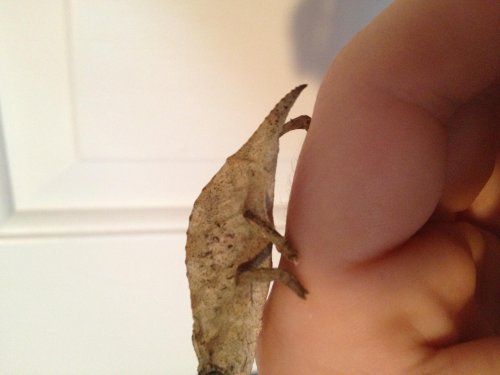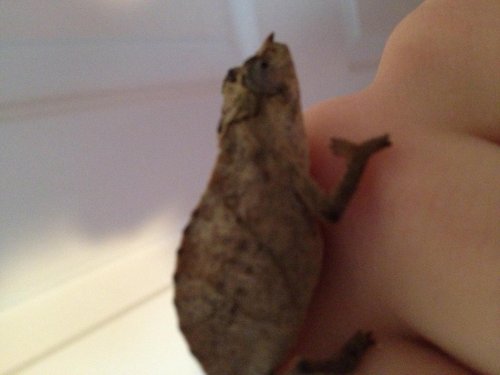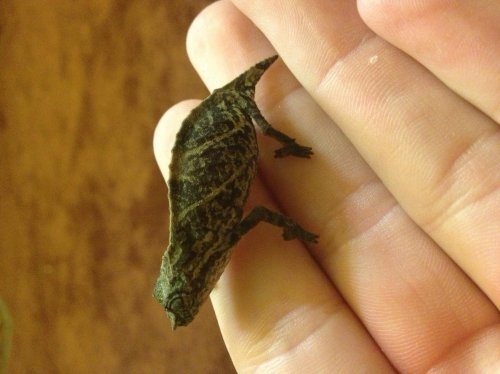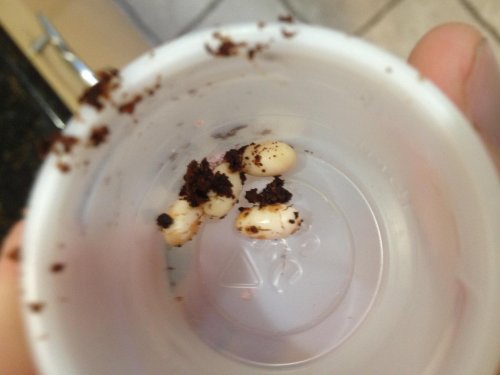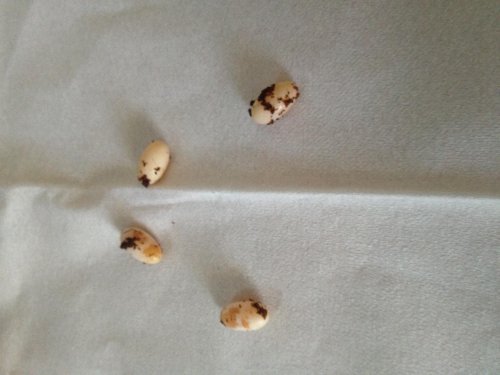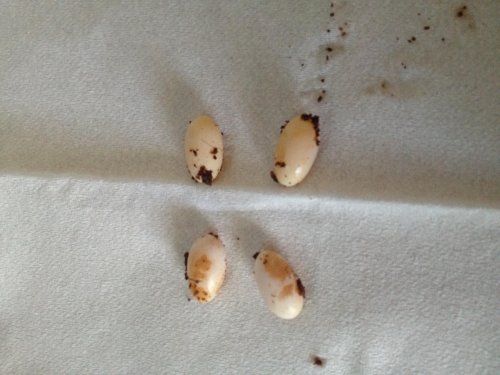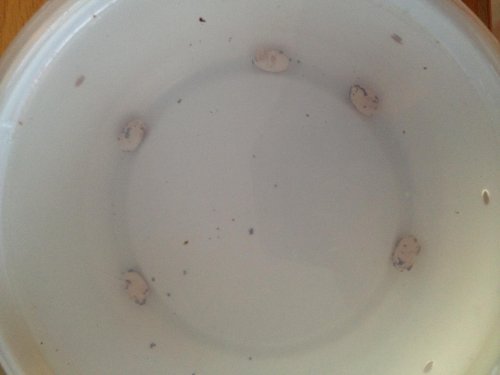Ok so long story short I recently acquired a gravid female R. Uluguru. The past few days she has been wandering the cage for a place to lay her eggs but I don't know why she hasn't yet. I know for sure she's gravid because he shows the coloration and I have even felt the eggs in her because yesterday I was cleaning her setup and I had to hold her and I felt the eggs. I'm not too sure why she hasn't laid the eggs yet but I hope she doesn't end up dying eggbound. However when she lays the eggs, how long do they take to hatch, what temperature should I incubate them at, and how much baby R. Uluguru are worth. I'm not soo new to chameleons however I'm new to gravid females/ breeding. Please let me know what to do, any information helps! Thanks 
Navigation
Install the app
How to install the app on iOS
Follow along with the video below to see how to install our site as a web app on your home screen.
Note: This feature may not be available in some browsers.
More options
You are using an out of date browser. It may not display this or other websites correctly.
You should upgrade or use an alternative browser.
You should upgrade or use an alternative browser.
Gravid R. Uluguru
- Thread starter yankee21h
- Start date
Chris Anderson
Dr. House of Chameleons
When you say "R. Uluguru", I am guessing you mean R. uluguruensis, but this species is rarely imported and difficult to differentiate from a number of other similar species that are imported more frequently. Can you post photos of your cham so we can help make sure it has been IDed properly?
Chris
Chris
Yeah, I mean R. uluguruensis. The problem is I made the account some time ago but I'm not a very frequent user, I'm not too sure how to post pics here, do you mind giving me your email so I can email you pics of her? By the way what should I do in regards to her laying her eggs?
Chris Anderson
Dr. House of Chameleons
Yeah, you're welcome to email me the pics and I'll upload them to this thread for you. My email address is in my signature but it is: [email protected]
Can you describe your setup for her so we can tell you what changes should be made to help promote egg laying?
Chris
Can you describe your setup for her so we can tell you what changes should be made to help promote egg laying?
Chris
Thank you so much and I just now sent you an email. She is approximately only an inch and a half long and I have her in a 12" x 12" x12". But in the terrarium I have her in the zoomed eco earth coconut fiber bedding, about 2-3 inches deep, a few live plants and dead leaves in there as well with 1 or 2 fake plants. It is also fairly damp in there as well. Humidity about 65%, temperatures about 78 degrees Fahrenheit. She lives in the cage solitarily. Let me know if I need to make any changes, or if the terrarium is too small or too big for her. Thanks.
Chris Anderson
Dr. House of Chameleons
Attached are the photos you sent me so others following the thread can see as well.
It is definitely a female of one of the R. uluguruensis-like species, but I can't tell which from the pictures. None of these species are frequently imported, so I was expecting when you sent the photos that it would be another, more easily IDed species. To differentiate between R. uluguruensis, R. moyeri and R. nchisiensis, I need to have you look for armpits under her front and rear arms.
Here is what a pit will look like if they are present:

Here is what it will look like if the pit is absent:

Based on the combination of presence/absence for the dermal pits in the axillary (front arm) and inguinal (groin/rear legs) areas, I can tell you which of the three species she is. In the mean time, here is an article that has a lot of information on these species (although the one species it doesn't specifically address care wise is R. uluguruensis): http://www.chameleonnews.com/07FebHildenhagen.html
As for your enclosure and encouraging laying, 12x12x12 is a little smaller than I like for a single pygmy chameleon. I could recommend at least a 10 gallon sized enclosure for a single animal, and 18x18x18 would be ideal for either a single or pair. The natural substrate is good for encouraging egg laying, but is yours the fine or course fiber? It should be fine (like soil). I would make sure that there are areas that are moist and others that are dry, and you might also include some sphagnum moss in areas as well. Here is a good article on setting up a pygmy chameleon enclosure: http://www.chameleonnews.com/05JunRouthouska.html
Chris
It is definitely a female of one of the R. uluguruensis-like species, but I can't tell which from the pictures. None of these species are frequently imported, so I was expecting when you sent the photos that it would be another, more easily IDed species. To differentiate between R. uluguruensis, R. moyeri and R. nchisiensis, I need to have you look for armpits under her front and rear arms.
Here is what a pit will look like if they are present:

Here is what it will look like if the pit is absent:

Based on the combination of presence/absence for the dermal pits in the axillary (front arm) and inguinal (groin/rear legs) areas, I can tell you which of the three species she is. In the mean time, here is an article that has a lot of information on these species (although the one species it doesn't specifically address care wise is R. uluguruensis): http://www.chameleonnews.com/07FebHildenhagen.html
As for your enclosure and encouraging laying, 12x12x12 is a little smaller than I like for a single pygmy chameleon. I could recommend at least a 10 gallon sized enclosure for a single animal, and 18x18x18 would be ideal for either a single or pair. The natural substrate is good for encouraging egg laying, but is yours the fine or course fiber? It should be fine (like soil). I would make sure that there are areas that are moist and others that are dry, and you might also include some sphagnum moss in areas as well. Here is a good article on setting up a pygmy chameleon enclosure: http://www.chameleonnews.com/05JunRouthouska.html
Chris
Attachments
Well the substrate is fine fiber. As for the pits she does seem to possess them on the frontal arms but not on the rear arms. As for te cage size should I move her now or wait until she lays the eggs. There are some parts moist and some that are dry like it should be. And I read through both links and they cleared up alot of questions I had. Let me know which species I have and what you reccomend I do about the laying, thanks!
Chris Anderson
Dr. House of Chameleons
Well the substrate is fine fiber. As for the pits she does seem to possess them on the frontal arms but not on the rear arms. As for te cage size should I move her now or wait until she lays the eggs. There are some parts moist and some that are dry like it should be. And I read through both links and they cleared up alot of questions I had. Let me know which species I have and what you reccomend I do about the laying, thanks!
If she has the axillary but lacks inguinal pits, she is Rhampholeon moyeri. That article I included has incubation information specific to this species, so that's good news.
As for moving or leaving her, how long have you had her in the enclosure she is in? On the one hand, you don't want to stress her too much before she lays if she's adjusted to the enclosure, but on the other, if she hasn't adjusted, moving her to a larger enclosure may be better. Does she seem to be active, but have a routine (such as a few typical areas you tend to find her in, etc.)?
Chris
Actually my mistake she has both kinds of pits so she isn't an R. Moyeri. And I've only had her for about a week or so in general and in the enclosure she's in and she seems happy and not overcrowded she never has stressed out colors. I'd say she's adjusting quite nicely. As for active or a routine she's somewhat active, however she tends to always stray on the bottom she never really climbs the foliage, she's always crawling around on the dirt and in the dead leaves. I also have 2 other enclosures one with a male R. Viridis and the other with a huge(3+ inch) female R. Brevicaudatus, she isn't gravid however I don't really have a way of getting a male for her so I'm not sure if I should sell her. She is in a 12" x 12" x 18" enclosure.
Chris Anderson
Dr. House of Chameleons
If she has both then she is R. uluguruensis. I would still incubate and keep as you would R. moyeri, however.
If she seems to be settling in well, I would leave her for the time being. You might try to get a larger enclosure set up, but until she lays, you want to minimize stress, and moving her again may be unnecessary.
Chris
If she seems to be settling in well, I would leave her for the time being. You might try to get a larger enclosure set up, but until she lays, you want to minimize stress, and moving her again may be unnecessary.
Chris
Trace
Captain Awesome
Wow! I haven’t seen one of those in forever! Chris covered most things so I don’t have too much more to add but the babies are tiny; much smaller than say the R. brevicaudatus or the Rh. temporalis. We started them on springtails and the smallest of fruit flies. Incubation time was about 100 days at approximately 65F. I can not find my notes on gestation time sadly.
So guess what everybody, yes that's right. Today's the day she finally laid a clutch of 4 beautiful eggs  I've been waiting all this time, 2 of them kinda have this weird coloring but overall I think they're fertile, Chris can I send you pics of the eggs that I took and you tell me how they are? Thanks.
I've been waiting all this time, 2 of them kinda have this weird coloring but overall I think they're fertile, Chris can I send you pics of the eggs that I took and you tell me how they are? Thanks.
Chris Anderson
Dr. House of Chameleons
So guess what everybody, yes that's right. Today's the day she finally laid a clutch of 4 beautiful eggsI've been waiting all this time, 2 of them kinda have this weird coloring but overall I think they're fertile, Chris can I send you pics of the eggs that I took and you tell me how they are? Thanks.
Awesome, glad she laid alright. You're welcome to send me the pics and I will post them up for you.
Chris
The pics are on their way, and also I just so happened to find a 5th egg! So now we got 5 eggs, now I was wondering, could I use perlite for the incubation bedding because I do not have vermiculite and I'm afraid if I order some online, it will take too long to come, and there is no place near me at all that sells it, however I have perlite, and it isn't the miracle grow kind, so that's good.
Chris Anderson
Dr. House of Chameleons
Attached are the pics of the eggs you sent.
They are a little off color but may still be good. The ones with the yellow patches may not be though. you should incubate them all anyway and see what happens. Infertile eggs tend to collapse or mold over before too long.
Chris
They are a little off color but may still be good. The ones with the yellow patches may not be though. you should incubate them all anyway and see what happens. Infertile eggs tend to collapse or mold over before too long.
Chris
Attachments
Hi there,
Congrats so glad she laid ok for you Ive kept & bred this species myself losing my last male a couple of months ago he was just over 2 yrs a very sad day. My female laid 9 clutches in total averaging 1 clutch of 4 every month. 4 clutches were laid even after my male passed away all having some fertile eggs. They took approx 110 days to hatch i used cocofibre with a little sphagnum moss mixed in. temps were 20.5 degrees day 19 degrees night. My biggest problem was getting them to hatch all went full term & split the egg but most died before breaking out. So hope everything goes well for you & you dont have the same problem.
Ive kept & bred this species myself losing my last male a couple of months ago he was just over 2 yrs a very sad day. My female laid 9 clutches in total averaging 1 clutch of 4 every month. 4 clutches were laid even after my male passed away all having some fertile eggs. They took approx 110 days to hatch i used cocofibre with a little sphagnum moss mixed in. temps were 20.5 degrees day 19 degrees night. My biggest problem was getting them to hatch all went full term & split the egg but most died before breaking out. So hope everything goes well for you & you dont have the same problem.
Heatherxxx
Congrats so glad she laid ok for you
Heatherxxx
Similar threads
- Replies
- 22
- Views
- 5K
- Replies
- 3
- Views
- 1K




